

FSC Forest Stewardship Council España (FSC-ES) · Home. Is 'Progress' Good for Humanity? The stock narrative of the Industrial Revolution is one of moral and economic progress.

Indeed, economic progress is cast as moral progress. The story tends to go something like this: Inventors, economists, and statesmen in Western Europe dreamed up a new industrialized world. Fueled by the optimism and scientific know-how of the Enlightenment, a series of heroic men—James Watt, Adam Smith, William Huskisson, and so on—fought back against the stultifying effects of regulated economies, irrational laws and customs, and a traditional guild structure that quashed innovation.
By the mid-19th century, they had managed to implement a laissez-faire (“free”) economy that ran on new machines and was centered around modern factories and an urban working class. Could Fighting Global Warming Be Cheap and Free? This just in: Saving the planet would be cheap; it might even be free.
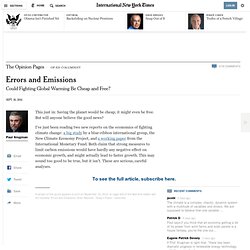
But will anyone believe the good news? I’ve just been reading two new reports on the economics of fighting climate change: a big study by a blue-ribbon international group, the New Climate Economy Project, and a working paper from the International Monetary Fund. Both claim that strong measures to limit carbon emissions would have hardly any negative effect on economic growth, and might actually lead to faster growth. This may sound too good to be true, but it isn’t. These are serious, careful analyses. Green Choices - Environmental impacts of clothing. Different fabrics have different impacts, depending on what they’re made of: Nylon and polyester Made from petrochemicals, these synthetics are non-biodegradable as well, so they are inherently unsustainable on two counts.

Nylon manufacture creates nitrous oxide, a greenhouse gas 310 times more potent than carbon dioxide. Making polyester uses large amounts of water for cooling, along with lubricants which can become a source of contamination. Both processes are also very energy-hungry. Rayon (viscose) This is another artificial fibre, made from wood pulp, which on the face of it seems more sustainable. Cotton Natural fibres have their problems, too. Wool Both agricultural and craft workers in the UK suffer from exposure to organophosphate sheep dip. Manufacturing processes. Environmental Impact Analyser. Forum for the Future and AkzoNobel have developed the Environmental Impact Analyser (EIA) as a tool to help businesses develop more sustainable products, and it has already been used to help AkzoNobel launch a range of Dulux paint with significantly lower environmental impacts.
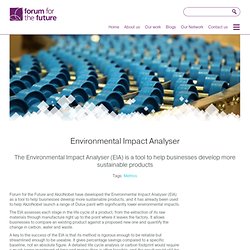
The EIA assesses each stage in the life cycle of a product, from the extraction of its raw materials through manufacture right up to the point where it leaves the factory. It allows businesses to compare an existing product against a proposed new one and quantify the change in carbon, water and waste. A key to the success of the EIA is that its method is rigorous enough to be reliable but streamlined enough to be useable. It gives percentage savings compared to a specific baseline, not an absolute figure. Anticipating the Environmental Effects of Technology. 2.12 Types of impacts EnTA focuses on characterising potential impacts associated with outcome categories, or endpoints.
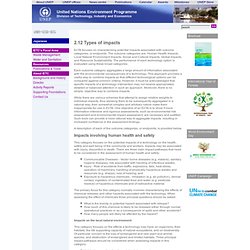
The outcome categories are: Human Health Impacts, Local Natural Environment Impacts, Social and Cultural Impacts, Global Impacts, and Resource Sustainability. The performance of each technology option is evaluated using these broad categories. Each outcome category aggregates a large amount of information associated with the environmental consequences of a technology. This approach provides a useful way to combine impacts so that different technological options can be compared against common criteria.
While there are various schemes that attempt to assign relative weights to individual impacts, thus allowing them to be subsequently aggregated in a rational way, their somewhat complex and arbitrary nature make them inappropriate for use in EnTA. A description of each of the outcome categories, or endpoints, is provided below. 050602environcs_000.pdf. Indicadores utilizados en el análisis de ciclo de vida - wikidiseno. Ecodiseño de un producto - Metodología de los eco-indicadores Uno de los métodos ACV existentes es el de los eco-indicadores, que consiste en dar cierto valor numérico a cada uno de los elementos del inventario, de manera que la suma de estos valores proporciona un resultado que mide la calidad medioambiental del producto.
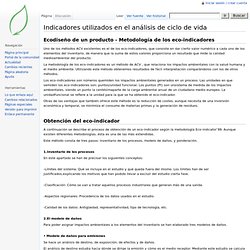
La metodología de los eco-indicadores es un método de ACV , que relaciona los impactos ambientales con la salud humana y el medio ambiente. Utilizando este método obtenemos resultados de fácil interpretación comparándolos con los de otros métodos. Los eco-indicadores son números quemiden los impactos ambientales generados en un proceso. Las unidades en que semiden los eco-indicadores son: puntos/unidad funcional. Otras de las ventajas que también ofrece este método es la reducción de costes, aunque necesita de una inversión económica y temporal, se minimiza el consumo de materias primas y la generación de residuos. Obtención del eco-indicador 1.Inventario de los procesos.
Ecological indicator. Ecological indicators are used to communicate information about ecosystems and the impact human activity has on ecosystems to groups such as the public or government policy makers.

Eipro_report.pdf. Product Environmental Impact. Much of our company’s environmental impact comes from other organizations manufacturing materials on our behalf.
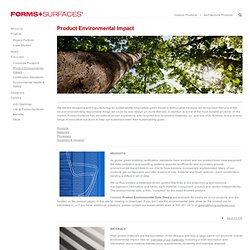
To control these impacts to the best of our ability, we manage procurement of raw material through our vendor selection and certification processes. In accordance with our environmental policy, we prefer recycled and recyclable materials, responsibly harvested wood, and low-VOC cleaners, paints and adhesives. We are continuously searching the world for suppliers and partners with unique materials or technologies that can help advance our supply base and expand the pallet for our design group. Environmental Impact of Materials. Skip to main content Country Global Global GlobalDenmarkFinlandGermanyNorwayPolandRussiaSweden Search form.
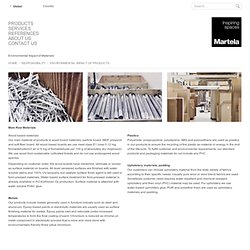
DTIx1262xPA-PriorityProductsAndMaterials_Report.pdf. PriorityProductsAndMaterials_Summary_EN.pdf. UK Centre for Materials Education.